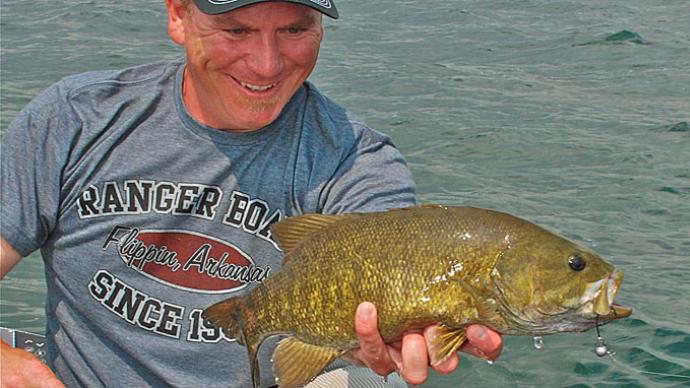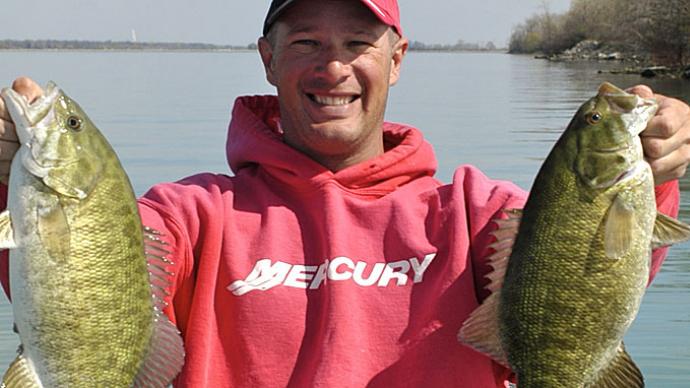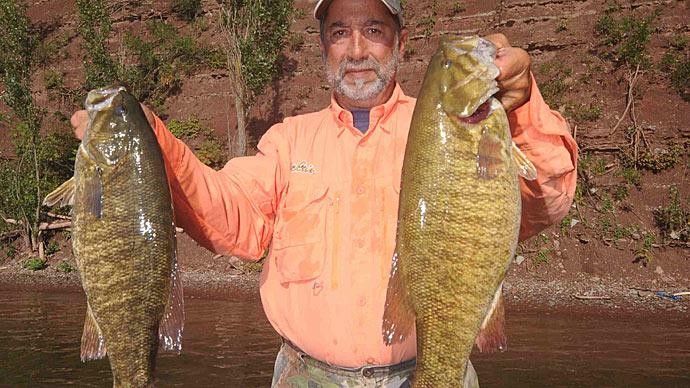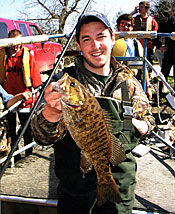
My Grandfather was a fisherman. He and I would walk along the shore of Cannonsville Reservoir, in southwestern Delaware County, New York, for hours on hot summer days and look for large exposed rocks on the steep cobble shoreline. "Cast that devil right behind that rock" he'd tell me, referring to the vibrating daredevil lure at the business end of my line. Make the right cast and nine times out often a beautiful bronzeback would come flying out of the water and Gramps' face would bust out into a huge grin. "Now that's a black bass!" he'd shout. Grandpa's favorite fish was the smallmouth bass. He would rather catch a smallmouth than any other fish.
Gramps was right. Smallmouth bass are one of the hardest fighting, most acrobatic fish a freshwater fisherman can chase. And. in my opinion, smallmouth bass are underutilized in ponds. That is understandable because much of the Deep South has water temperatures too warm for smallies. After all, they are a cool water fish, preferring temperatures around 65-75F. Smallmouth really don't like it much over 8OF.
Smallmouth bass spawn in my home state of New York when water temperatures are in the low 60's during daylight hours. Smallmouths spawn in Spring, in shallow water over gravelly bottoms. Males normally sweep out and guard the nest until eggs hatch, which may take up to 3 weeks, depending on temperature. Smallmouths have the reputation of being the cleaner water, tastier cousin of largemouth.
In the last Pond Boss article, "Starting Your Baitfish Cocktail", touting the fathead minnow, golden shiner and papershell crayfish combination, we set the stage for a smorgasbord for gamefish. That article concluded with a teaser. Are you doomed for a "bass on bass" pond when stocking largemouth bass in small Northern ponds?

Maybe so, maybe no. Largemouth bass are bully predators and can eat your small pond out of most (and probably all) of its forage. Are smallmouth bass a better option for a northern or Midwestern pond? Well... maybe.
Here is the scenario. You want a bass pond. Your pond is built and stocked with fatheads, golden shiners and papershell crayfish with appropriate habitat for these creatures to breed like a raging wildfire for an entire year. Your pond is a newly created baitfish Mecca, with fatheads galore, giant cow-size golden shiners and papershell crayfish in the mud everywhere. You throw in the designated number of largemouth bass fingerlings and all your precious baitfish are eaten by these bigmouth hogs in a few short years. I have seen only one bass-shiner lake hold on for 10 years before the last large shiner succumbed. What if you stocked smallmouth bass instead of the largemouth gluttons?
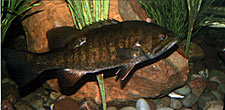
Bronzebacks are opportunistic predators which feed on tadpoles, frogs, crayfish and insects. But... fish still make up most of their diet. So, why would smallmouth be less likely to decimate your baitfish cocktail? Well, like the name says, largemouth have a larger mouth. No kidding, Cornwell, you fisheries biologist, you? As prey fish length approaches maximum gape of a predator (fancy fish lingo for how wide a predator can open its mouth), it becomes more difficult for that predator to handle. Makes sense, doesn't it? It may be more beneficial for that predator to go after smaller prey fish due to increased handling time and almost choking to death on that big cow golden shiner. Let's say you stock 100-150 smallmouth (6-8") per acre in your baitfish Mecca. The first thing smallmouth do is pound the heck out of the fatheads. Fatheads are completely decimated in two years. These fatheads will give your bass a nice jumpstart in growth. That's their job. While fatheads are going the way of the buffalo, shiners should be maturing into golden cows too large for young smallmouths to get their small mouths around. Largest year classes of shiners will be difficult for smallmouth to choke down. Shiners will continue producing forage for years to come.
Just today, a New York pondmeister asked me, "How will a combination of largemouth and smallmouth do?" In a small pond with limited habitat diversity? Not well! Largemouth bass are hogs. Period. Take a look at the graph of 40 acre Moe Pond in upstate New York, where golden shiners, smallmouth and then largemouth bass populations have been studied for 15 years. In 1994, this pond had golden shiners. That was the only fish. Water was deep green color because shiners were eating large zooplankton that normally keep phytoplankton and microscopic algae grazed out of the water. Then, a bucket biologist stocked smallmouth bass. Shiners took a hit, but persisted. Largemouth bass were introduced, again as an unauthorized introduction. Both the shiners and smallmouth bass took a big hit. Pond water cleared up as large zooplankton returned. Largemouth bass numbers increased, shiners decreased. By 2004, shiners are gone, folks. Gone.

Smallmouth bass in Moe Pond are on their way out too. In 1999, for every smallmouth sampled, there were 1.6 largemouth bass. In 2000, this ratio increased to 2.7 and then to 7.4 in 2001. In 2005, for every smallmouth bass present in Moe Pond there were 54 largemouth bass sampled. Storyline: largemouth bass win! Incidentally, this lake had the highest largemouth bass catch rate of any lake I have personally ever electrofished, at over 700 bass per hour. This ratio is exceptionally high. Interestingly, largemouth bass have not only replaced smallmouth, they have also replaced the niche of the shiner. Since largemouth bass are stunted, and of similar size, it is hard for them to feed on other bass in the pond. Instead, they are feeding primarily on zooplankton and are filling the role once occupied by the shiner. The pond is green again! Bass are small and extremely overcrowded.
What is the moral of this long story? Unless you have a sizeable lake with multiple species of prey and habitat diversity in the North or Midwest, it may be better to have smallies without largemouth present.
I frequently fish one small, local half acre pond where there are hundreds of cacheable size smallmouth (10-18") that still produces crops of golden shiners. Golden shiners and smallmouth bass are the only fish in this pond. This pond has been cruising along like this for nearly 20 years. Not bad for a small smallie pond!
Moe Pond data courtesy of Dr. Bill Harman, SUNY Oneonta Biological Field Station, 5838 State Hwy. 80, Cooperstown, NY 13326.
Mark Cornwell is a fisheries professor at SUNY-Cobleskill in Cohleskill, New York. His passion is raising walleye and the I.Q. of fisheries students in the Northeast.
Reprinted with permission from Pond Boss Magazine

